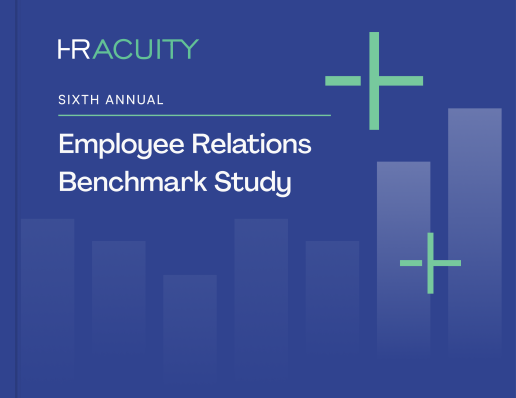This week HR Acuity published our Sixth Annual Employee Relations Benchmark Study. As I do every year, I review the data, look for trends and shoot straight with the community when I see red flags and areas where we need to improve. This year’s data didn’t surprise me with dramatic spikes and unforeseen trends like it did in 2020. Instead, it’s tedious flatlining speaks volumes about ER’s consistency and what I hope is just a temporary setback from the steady progress we were making before the pandemic. While on the surface that might make for boring charts, I take this as a sign that what we are seeing is indeed very real – and we need to talk about it sooner rather than later.
Areas where we stayed consistent show me that we are doing so many things right. For example, 92% of those relying on ER metrics track 9 different metrics for deeper insights! 88% of organizations are using a centralized or mixed approach. 72% of organizations use some sort of technology to track employee relations data. Finally, a consistency I’m very excited to see, two-thirds of ER teams continue sharing metrics directly with senior leadership. We are influencing business decisions, and that is a powerful reality we can all be proud of.
centralized or mixed approach. 72% of organizations use some sort of technology to track employee relations data. Finally, a consistency I’m very excited to see, two-thirds of ER teams continue sharing metrics directly with senior leadership. We are influencing business decisions, and that is a powerful reality we can all be proud of.
Now, let’s talk concerning flatlines and declines. While consistency might not seem all that exciting, flatlines and dips around key capabilities grab my full attention. Investigation processes remain vulnerable. Documentation still presents litigation risk. Transparency is actually down. We asked ER leaders to gauge confidence in their people leaders when it comes to handling issues; confidence is low.
As I look at the data, I see three clear opportunities for us to tap into our resilient natures and lead with impact. Over the next few weeks, I’ll dive deeper into each one with recommendations for how you can regain momentum in the second half of 2022.
Opportunity one: tightening scalable investigation processes.
Only 43% or organizations use required investigation processes, and just 28% currently train investigators once a year or more. Documentation is a big part of investigations and 53% of organizations are still using methods that compromise security, weaken accuracy and provide minimal reporting capabilities.
The steady and significant four-year upward trend in investigation processes peaked in 2019 but hit a downturn in 2020, flatlining in 2021. I’m unclear if the spike in 2019 was an anomaly in the wake of #MeToo or if this is in response to shifting priorities during the pandemic. Either way, I’m concerned with process stagnation. Why? Investigations are only going in one direction – up. Tight, required investigation processes are scalable processes. Every investigation is an opportunity to solidify employee trust.
Opportunity two: building trust by sharing outcomes with employees.
The percentage of organizations sharing aggregated, anonymous ER data with employees dropped from 29% pre-COVID to 17%. Of those that do share this data, only half share it once a year.
Why is this a red flag? Transparency drives accountability and builds trust by showing employees that issues and allegations will be taken seriously. When employees understand the process and see consistency, they feel better about the outcome even if they don’t like it.
Operating in a world with ‘trust issues at scale’ means that building trust in the organization is a huge differentiator right now. According to the latest Edelman Trust Barometer, business is the most trusted institution ahead of NGOs, government and media. 77% of respondents trust their employer, making the relationship between employer and employee something we must actively protect.
Opportunity three: empowering people leaders to handle issues on the front line.
We asked HR how confident they are in their people leaders to handle employee issues and concerns effectively. That number is hovering at 42% for those with a centralized model and 44% for those who are decentralized. Unsurprisingly, those who use ER technology report slightly more confidence at 48% than those who don’t (33%). Logic tells me those who have invested in ER technology have likely invested in more people leader training.
As organizations recover from the pandemic with more remote/hybrid workforces, the need for capable leaders who can confidently handle issues at the front line is critical. People leaders need instant access to updated policies, simpler workflows for documentation or escalation and, of course, more training and support for difficult conversations.
As this community knows, at its core, employee relations are measured by the actions we take in the moments that matter to employees. Right now, we need to seize our moment. Employee Relations professionals have never had such a huge opportunity to positively impact the business like we do today. With so many organizations consistently sharing metrics with the business, let’s stomp our foot on the pedal and regain our momentum.
Organizations are thriving or deteriorating based on employee trust – and we are the people who help build it or break it every day. What we decide to do at this moment will be the difference between staying down for the count or turning a setback into a step up. Let’s help each other bounce back from the blows we took in 2020.
As always, I couldn’t be happier to be part of the community that will lead the charge.
To read the full report, Download the Sixth Annual Benchmark Study here.



